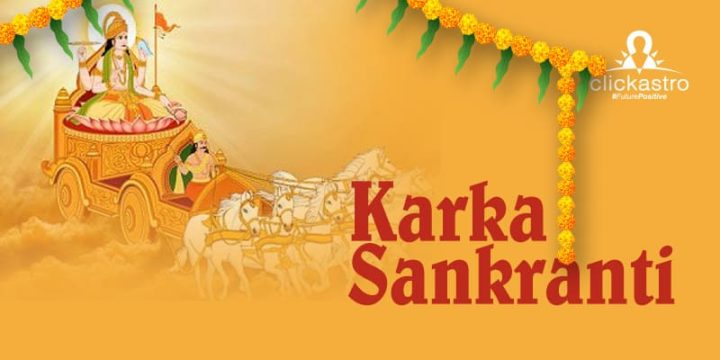Karka Sankranti is the day when the Sun enters the Karka rashi (Cancer). This is a significant event in the
Hindu calendar as this day heralds the commencement of the Sun’s journey towards the south, termed Dakshinayana. The event is marked by various rituals and traditions, reflecting deep cultural and spiritual significance. Celebrated with devotion, Karka Sankranti is a time for worship, fasting, charity, and paying homage to Lord Vishnu and the Sun God.
Karka Sankranti 2024 is on Tuesday, 16th of July.
Astronomical Significance
Karka Sankranti marks the Sun’s transition into the Cancer zodiac sign, initiating the Dakshinayana phase. This six-month period is significant in Hindu astronomy as it symbolizes the Sun’s southward journey. During Dakshinayana, days become shorter, and the influence of the water element grows stronger, bringing a shift in seasonal energies. This period contrasts with Uttarayana, the northward movement of the Sun, characterized by longer days and the dominance of the fire element, associated with heightened vitality and positive energies.
The shift into Dakshinayana is traditionally considered less auspicious for starting new ventures due to the prevailing belief that it empowers negative or malevolent forces. Consequently, many avoid undertaking significant activities or launching new projects during this time. The influence of the water element during Dakshinayana also aligns with the onset of the monsoon season, which is crucial for agriculture, reinforcing the interconnectedness of celestial movements and earthly cycles.
Important Timings On Karka Sankranti 2024
- Sunrise – July 16, 2024 5:54 AM
- Sunset – July 16, 2024 7:11 PM
- Sankranti Moment – July 16, 2024 11:20 AM
- Punya Kaal Muhurta – July 16, 5:54 AM – July 16, 11:20 AM
- Maha Punya Kaal Muhurta – July 16, 10:56 AM – July 16, 11:20 AM
Rituals and Traditions
Sacred Bath and Fasting
The day of Karka Sankranti begins with a sacred bath at sunrise, an act believed to purify the body and soul. This ritual bath, often taken in holy rivers, is a symbolic gesture of cleansing oneself from past sins and starting anew. Following the bath, many devotees observe a fast throughout the day. Fasting is not only a means of seeking divine blessings but also a way of demonstrating self-discipline and spiritual dedication. The combination of bathing and fasting aims to prepare the devotee physically and mentally for the worship and charitable activities that follow.
Worship of Lord Vishnu
Central to the observance of Karka Sankranti is the worship of Lord Vishnu, the preserver and protector in the Hindu trinity. Devotees perform elaborate pujas (worship rituals) and recite the Vishnu Sahasranama Stotram, a sacred hymn consisting of a thousand names of Lord Vishnu. This recitation is believed to invoke the deity’s blessings, bringing peace, prosperity, and good fortune to the devotees. The Vishnu Sahasranama is revered for its spiritual potency and is often chanted with deep devotion and reverence.
Charity (Daan)
Charity, or daan, plays a significant role in the rituals of Karka Sankranti. Acts of generosity are highly encouraged, with devotees donating grains, clothes, oil, and other essentials, especially to the Brahmin community. These charitable acts are considered immensely rewarding, both spiritually and materially. The practice of daan on Karka Sankranti is rooted in the belief that helping those in need, particularly learned Brahmins, brings about spiritual merit and divine favour. This tradition underscores the importance of compassion and community support in Hindu culture.
Homage to the Sun God
Prayers and offerings to the Sun God, Surya, form an integral part of Karka Sankranti rituals. Devotees seek the Sun God’s blessings for health, vitality, and overall well-being. The Sun is revered as the life-giver and sustainer of all living beings, and paying homage to Surya on this day is believed to enhance one’s physical and mental strength. Offerings typically include water, flowers, and other symbolic items that are presented during the prayer ceremonies. This practice highlights the deep connection between celestial movements and earthly life in Hindu philosophy.
Avoidance of New Ventures
Karka Sankranti is traditionally considered inauspicious for starting new projects or significant endeavours. This belief stems from the notion that the transition into the Dakshinayana phase brings about dominance of the water element, which is associated with negative or malevolent energies. As a result, it is advised to refrain from initiating any major activities or making significant decisions during this period. This cautionary approach reflects the broader Hindu understanding of cosmic rhythms and their influence on human life, emphasizing the importance of aligning one’s actions with favourable astrological timings.
Significance of Karka Sankranti
Karka Sankranti holds deep spiritual and cultural importance in the Hindu tradition. This festival marks the onset of the monsoon season, which is crucial for agriculture, a cornerstone of the nation’s economy. The arrival of rains rejuvenates the land, ensuring the growth of crops that sustain millions.
During the Dakshinayana phase, spanning six months starting from Karka Sankranti, it is believed that the Gods enter a period of rest. As a result, devotees avoid initiating new projects or significant endeavours during this time, adhering to the belief that auspicious energies are subdued. This period is seen as a time for introspection, spiritual growth, and maintaining existing practices rather than embarking on new ventures.
The cycle concludes with
Makar Sankranti, marking the beginning of Uttarayana, a phase characterized by increased vitality, longer days, and favourable conditions for new beginnings. This transition signifies a renewal of positive energies and is celebrated with great fervour, reflecting the deep connection between celestial events and earthly life in Hindu culture.
Reverence to Ancestors
Karka Sankranti is a significant time for performing Pitra tarpan, a ritual dedicated to honouring and providing solace to departed ancestors. This ritual involves offering water, sesame seeds, and other sacred items to the spirits of deceased family members, seeking their blessings and peace for their souls.
Many devotees specifically await Karka Sankranti to perform these rites, as it is believed that the Dakshinayana phase, beginning on this day, is particularly auspicious for ancestral worship. By conducting Pitra tarpan, individuals express gratitude and reverence towards their forebears, acknowledging the enduring bond between the living and the deceased.
This practice underscores the importance of familial ties and the continuity of traditions across generations. It also reflects the broader Hindu belief in the cyclical nature of life and death and the enduring impact of ancestors on the well-being of their descendants. Through these rituals, devotees seek to ensure peace and contentment for their ancestors in the afterlife.
Conclusion
Karka Sankranti is more than just a celestial event; it is a day imbued with deep religious and cultural practices that reflect the rich tapestry of Hindu traditions. From fasting and charity to worship and reverence for ancestors, each aspect of this festival underscores a commitment to spiritual growth, communal harmony, and respect for natural cycles. As devotees observe Karka Sankranti on July 16, 2024, they participate in a tradition that has been cherished and upheld for generations, fostering a sense of continuity and devotion.








